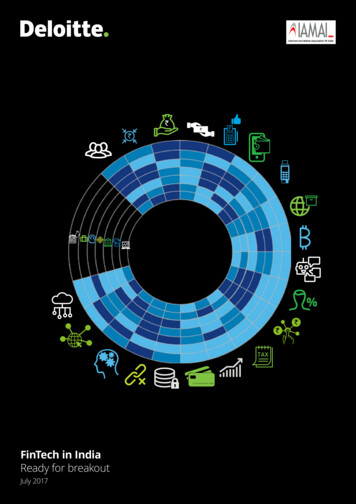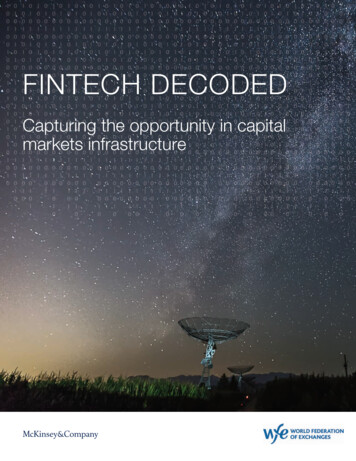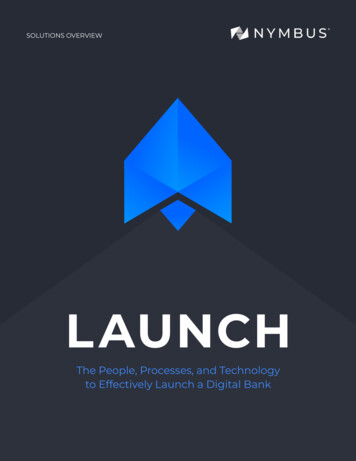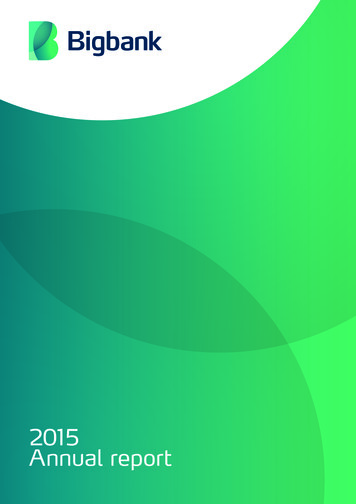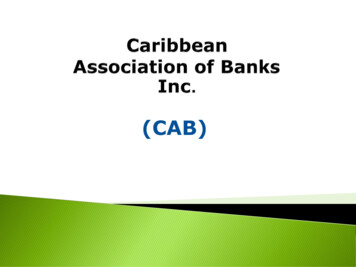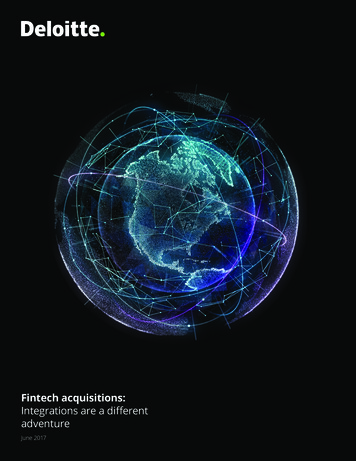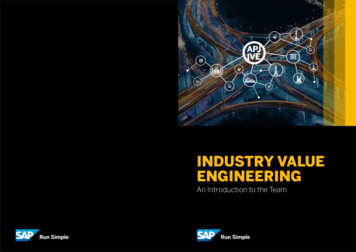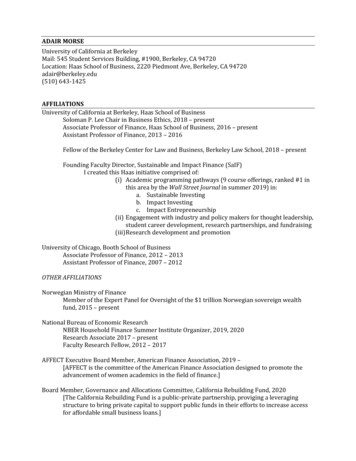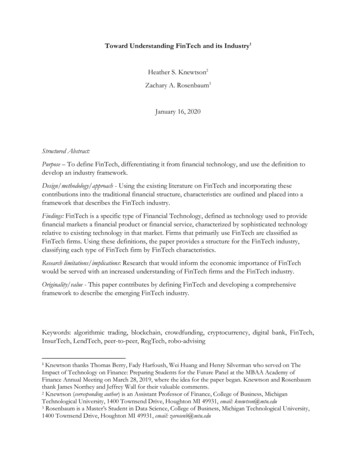
Transcription
Toward Understanding FinTech and its Industry1Heather S. Knewtson2Zachary A. Rosenbaum3January 16, 2020Structured Abstract:Purpose – To define FinTech, differentiating it from financial technology, and use the definition todevelop an industry framework.Design/methodology/approach - Using the existing literature on FinTech and incorporating thesecontributions into the traditional financial structure, characteristics are outlined and placed into aframework that describes the FinTech industry.Findings: FinTech is a specific type of Financial Technology, defined as technology used to providefinancial markets a financial product or financial service, characterized by sophisticated technologyrelative to existing technology in that market. Firms that primarily use FinTech are classified asFinTech firms. Using these definitions, the paper provides a structure for the FinTech industry,classifying each type of FinTech firm by FinTech characteristics.Research limitations/implications: Research that would inform the economic importance of FinTechwould be served with an increased understanding of FinTech firms and the FinTech industry.Originality/value - This paper contributes by defining FinTech and developing a comprehensiveframework to describe the emerging FinTech industry.Keywords: algorithmic trading, blockchain, crowdfunding, cryptocurrency, digital bank, FinTech,InsurTech, LendTech, peer-to-peer, RegTech, robo-advisingKnewtson thanks Thomas Berry, Fady Harfoush, Wei Huang and Henry Silverman who served on TheImpact of Technology on Finance: Preparing Students for the Future Panel at the MBAA Academy ofFinance Annual Meeting on March 28, 2019, where the idea for the paper began. Knewtson and Rosenbaumthank James Northey and Jeffrey Wall for their valuable comments.2 Knewtson (corresponding author) is an Assistant Professor of Finance, College of Business, MichiganTechnological University, 1400 Townsend Drive, Houghton MI 49931, email: knewtson@mtu.edu3 Rosenbaum is a Master’s Student in Data Science, College of Business, Michigan Technological University,1400 Townsend Drive, Houghton MI 49931, email: zarosenb@mtu.edu1
Toward Understanding FinTech and its Industry1“The magical combination of geeks in T-shirts and venture capital that has disrupted other industries has putfinancial services in its sights.” (2015)IntroductionIn a surprisingly prescient manner, FinTech was defined by Bettinger (1972) as, “ anacronym which stands for financial technology, combining bank expertise with modern managementscience techniques and the computer.” Nearly fifty years later, the widespread adoption of thepersonal computer and the existence of the internet and mobile connectivity, the current state ofFinTech deserves a fresh treatment.Finance has been characterized by technology throughout its history as noted by Ferguson(2018). He asserts innovations have been the cornerstone of finance. including the earliest uses ofmoney, the introduction of Arabic numerals and interest theory, the birth of the bond markets inItaly, creation of the joint-stock company and the secondary market for shares in the Netherlands,through modern manifestations via central banking, ATMs, and digital currency. Yet it appears thatFinTech has unleashed something beyond the normal path of financial technology. How rapid is thisadvance now? A search in ABI/INFORM shows the usage of the term FinTech has grown twentyfive-fold over the past decade to over 1,000,000 works containing the term FinTech, spawned by anew industry of FinTech firms (Figure 1). The FinTech industry is the focus of this paper.Figure 1To encourage FinTech research, The Review of Financial Studies issued a novel call for a specialissue dedicated to FinTech (Goldstein et al., 2019). Financial Management similarly published a specialissue regarding FinTech (Parlour, 2019) and the Journal of Corporate Finance has issued a Call forPapers for a conference and special issue on FinTech and Digital Finance. These were preceded by a2017 conference, jointly sponsored by the Federal Reserve Bank of Philadelphia and the New YorkStern School of Business (Jagtiani and John, 2018)Jensen and Meckling (1976) theorized that a firm is a nexus of contracts. The nature of thesecontracts governs what types of products and services different firms will provide. While nothing1
prevents a firm from shifting its strategy, in practice firms often organize along lines of businessrecognized as industries. In a traditional sense, the FinTech industry defies easy classification.Although products and services provided by the industry are financial in nature, the processes andtools are mostly from the technology industry. FinTech industry classification is predicated ondefining the term FinTech.When people use the term FinTech, it is unclear whether they are envisioning the sameconcept. Buzzwords used by the financial press are meant to pique interest, but can confoundmatters unnecessarily. In fact, it appears that FinTech has fallen victim to a dilution in meaning. AsFigure 1 shows, both the popular press and academe now regularly use the term FinTech. Theabsence of a broadly accepted definition has led to cavalier use of the term. This creates a challengefor new research.This paper contributes in three ways. First, it defines the term FinTech: FinTech istechnology used to provide financial markets a financial product or financial service, characterizedby sophisticated technology relative to existing technology in that market. Second, it uses thedefinition of FinTech to identify FinTech firms and create an industry framework to increaseunderstanding of this emerging research area. Finally, it provides a description of firms in theindustry using this framework with characteristics set forth in the definition of FinTech.This paper is organized as follows. Section 2 includes a review of the FinTech literature.Section 3 develops the movement from financial technology to FinTech, defining FinTech in thissection. Section 4 provides a framework for the FinTech industry. Section 5 relates each node fromthe framework onto the definition of FinTech. Section 6 discusses some commonly heldmisconceptions about FinTech not otherwise addressed and Section 7 concludes.2Literature ReviewThis paper provides a flowchart entitled The FinTech Space (Figure 2), to organize the literaturereview. FinTech firms use Agile Technologies (I) to create FinTech Assets (IV) and FinTech Services (V).The Value of Agile Technologies (II) has impacts on how these technologies are held (OwnershipStructure). FinTech Firms comprise the FinTech Industry and give rise for the need to set industry AssetStandards (III). FinTech Regulation (VI) has been placed on both FinTech Firms and FinTech Services (V).Each of the numbered nodes I – VI from Figure 2 is treated in this literature review.Blockchain and machine learning are representative of Agile Technologies (I). Blockchain isperhaps the most popular FinTech innovation. Blockchain has received considerable treatment,including how blockchain mitigates settlement risk (Chiu and Koeppl, 2019), how blockchain canincrease trust in ecommerce (Cong and He, 2019), the benefits of blockchain to society (Biais et al.,2019), and the propensity of firms to strategically use FinTech terms like blockchain, bitcoin, orcryptocurrency in 8-K disclosures (Cheng et al., 2019). Research regarding machine learning hasbeen conducted on FinTech lending using alternate data (Jagtiani and Lemieux, 2018) and assetallocation (Routledge, 2019). From the management information systems literature, Gomber et al.(2018) documented the technological innovations which characterize FinTech.Chen et al. (2019) study the value of FinTech innovations using machine learning to identifyFinTech patents (Value of Agile Technologies (II)). Their algorithm classified innovations into seven2
areas: cybersecurity, mobile transactions, data analytics, blockchain, peer-to-peer, robo-advising, andthe internet of things (IoT). Though these innovations affect FinTech, some are more aptlyclassified at information technology firms, such as cybersecurity, data analytics, and IoT. Withrespect to price informativeness, a working paper by Grennan and Michaely (2019) studies increasedprice informativeness for stocks with FinTech data coverage, concluding investors rely on FinTechdata intelligence, in addition to traditional pricing sources.Figure 2With respect to FinTech Assets (IV), considerable research has been conducted oncryptocurrency, including bitcoin. (This paper differentiates cryptocurrency as an asset, from itsassociated technology blockchain.) Recent studies have considered the asset pricing properties ofcryptocurrency (Hu et al., 2019), the economics of bitcoins (Schilling and Uhlig, 2019), and priceprediction for bitcoins using machine learning (Chen et al., 2020).Regarding FinTech Services (V), firms such as banks and mortgage lenders now face FinTechcompetition. Buchak et al. (2018) classified banks without depository services as shadow banks, andinvestigated the services offered by FinTech and non-FinTech shadow banks, noting FinTechlenders make use of alternative information to set lending rates for borrowers. Nowak et al. (2018)noted small businesses seem able to signal their financial strength through self-description in peerto-peer lending descriptions. Fuster et al. (2019) researched the role of technology in a market ripefor streamlined processes, the mortgage market. They find the innovation offered by FinTechlenders reduces processing time 20% and does not simply target lower creditworthy customers.3
Vallée and Zeng (2019) researched the difference between conventional banking and anemerging FinTech area, peer-to-peer (P2P) lending, noting that credit decisions made in FinTechP2P lending uses different information than what is used in traditional credit decisions. This hasbecome increasingly important to serve millennials whom, because they are less likely to usetraditional credit channels, would be underserved without P2P lending. Tang (2019) investigatedwhether P2P lending is a complement to or substitute for banks, finding P2P serves both of theseroles, depending on the credit channel sought.Additional FinTech Services (V) include crowdfunding and robo-advising. Chemia and Tinn(2019) documented the benefits to firms using crowdfunding, as both an avenue to understandingcustomer demand prior to production, as well as a funding source. D’Acunto et al. (2019) studiedrobo-advising finding investors experienced benefits including increased diversification andreductions in certain behavioral biases in portfolio decision-making.Finally, FinTech Services (V) includes algorithmic trading, including high frequency trading(HFT). Hendershott et al. (2011) questioned whether market quality improved in the face ofalgorithmic trading. They found that spreads narrowed and adverse selection was mitigated,suggesting algorithmic trading improved liquidity. Menkveld (2013) used proprietary data as a casestudy investigation of the characteristics of high-frequency trading, finding this particular HFTserved as a market maker.The financial services industry has been working toward FinTech regulation andestablishment of Asset Standards (III). The International Token Standardization Association has beenworking on implementing ISO identifiers, and recently began working with Bloomberg’s ObjectManagement Group on the Financial Instrument Global Identifier. The Association for NationalNumbering Agencies is also working on digital identifiers. The Global Digital Finance Group isdeveloping rules of conduct to minimize the need for regulatory involvement.FinTech has been noticed by regulators (FinTech Regulation (VI)). The Financial StabilityBoard (FSB), an international body of representatives from over 20 countries provides oversight ofthe international financial system, published a paper about FinTech oversight in 2017 (Wilkins et al.,2017) The FSB defines FinTech as, “technology enabled innovation in financial services that couldresult in new business models, applications, processes of products with an associated material effecton the provision of financial services.” The FSB connects FinTech innovations to the worldeconomy with a regulatory framework to mitigate FinTech risks.This paper is closest to two recent works. First, Dandapani (2017) reviewed recentdevelopments in electronic finance considering the costs, benefits, and protections, focusing onpayment systems and additional areas of infrastructure: cloud computing, valuation metrics formultisided platforms, quantum trading, and cybersecurity. Das (2019) provided an important reviewof technologies (machine learning, artificial intelligence, network modeling, automated trading,blockchains and text analysis), discussing the implications for various areas of finance (riskmodeling, consumer finance, and payment systems.) In addition, Das (2019) discussed topics relatedto FinTech including cybersecurity, illicit finance and fraud prevention.While research has been conducted in areas surrounding the FinTech industry, this is thefirst paper focused on firm classification and providing an industry framework, which stands in the4
middle of The FinTech Space as noted in Figure 2. A better understanding of the breadth of FinTechFirms and the FinTech Industry is important to enable future research in areas such as OwnershipStructure and Firm Value, Capital Structure, Corporate Governance, and Security Issuance and Payout Policy.3From Financial Technology to FinTechThis paper begins by distinguishing Financial Technology from FinTech. Although FinTechoriginates from the phrase Financial Technology, FinTech is a proper subset of FinancialTechnology. Double-entry bookkeeping is Financial Technology essential to financial accounting,but it is not FinTech. Whereas, cryptocurrency is FinTech specifically as well as FinancialTechnology more generally. The definition for Financial Technology is:Financial Technology is technology used to provide financial markets a financial product or financial service.Figure 3The movement toward FinTech, a distinct type of Financial Technology, necessitates focuson the type of technology. In the spirit of the bell curve of innovation introduced by Rogers (1962),this paper defines The Tech Paradigm as an ordered space that tracks the lifespan of a giventechnology in a particular market (Figure 3). This space is partitioned into four ordinal levels oftechnology, from least to greatest: Obsolete, Mature, Status Quo, and Bleeding Edge. Bleeding Edgecombines the concepts of leading and cutting edge, which implies increased riskiness of quicklyadvancing, even unreliable, technology. Mature and Status Quo technologies enjoy the highest rates ofuse within a given market, whereas Obsolete and Bleeding Edge technologies experience the lowest.The Tech Paradigm illustrates this space is a relative measure for degree of uncertainty,potential for profitability, and relative resource efficiency. With increasing uncertainty, potential forprofitability, and relative resource efficiency, , firms are placed more rightward on The Tech Paradigm.For example, firms that prefer lower risk and more certain outcomes will likely use Maturetechnology. Non-FinTech financial firms, which will be referred to as incumbent firms, existsomewhere in the Obsolete, Mature, and Status Quo levels of technology. This paper proposes adefinition for FinTech as:FinTech is technology used to provide financial markets a financial product or financial service, characterizedby sophisticated technology relative to existing technology in that market.5
Thus, the definition of FinTech is a more focused definition of Financial Technology.Referring to The Tech Paradigm, Bleeding Edge technology is the sophisticated technology relative toexisting technology. With the definition of FinTech, it is now meaningful to define the FinTech Firm:A FinTech firm is a firm that primarily uses FinTech in its business model, to provide a financial product orfinancial service.The Tech Paradigm can be applied to any era, but the technologies residing in each level willdiffer depending on the era. Presently Bleeding Edge technology used in financial markets ischaracterized by increased computational power, more sophisticated infrastructure, and data-hungrymodels. Many of these technologies have existed for some time and are now being applied tofinance. For example, artificial neural networks are almost forty years old (Fukushima, 1980), buttheir application to financial markets has only recently been feasible due to the calculation timerequired for a sufficiently complex model.Incumbents can adopt Bleeding Edge technologies, but they do not adopt enough of them, norquickly enough for their business model to primarily rely on FinTech. This is true for two reasons.First, Bleeding Edge technology introduces more risk than incumbent firms are comfortable with.Second, incumbent firms are unable to make this transition because of their complexity. The abilityto leverage outside technology rapidly is the essence of FinTech firms, and incumbent firms cannotto keep pace with this rapidity. Thus, it is the usage of Bleeding Edge technology that is the essence ofFinTech firms. Without Bleeding Edge technology, FinTechs would be significantly less profitable,compared to incumbent firms already operating at scale with Mature and Status Quo technologies.4The FrameworkWithin the context of The FinTech Space (Figure2) and the levels of technology from The TechParadigm (Figure 3), this paper hones the definition of FinTech and develops categories based onattributes common to FinTech firms. This section defines three disjoint categories of commonattributes, namely: Relation to Financial Services, Technological Innovation, and Agility. This paper considersa subindustry to be FinTech if it has at least one attribute from each one of these three categories.FinTech firms operate in the financial services industry, but the nature of their relation tofinancial services differs based on their business model. FinTech firms operate by complementing ordisplacing current financial services firms, or by creating new financial services markets. Examples ofmarket creators are crowdfunding and cryptocurrency firms. The first category, Relation to FinancialServices, includes Complementing, Displacing and Market Creating: Complementing: Has a core business that complements traditional finance by offering productsor services to traditional financial entities. This supporting role exists because traditionalfinancial entities are typically too slow to develop these solutions. Displacing: Has a core business model that competes for a market which has been previouslycultivated or sustained by traditional financial entities. Market Creating: Has a core business that creates a new financial product or service whichserves a previously unmet or underserved market.6
For example, Robinhood is a brokerage app that offers a zero-transaction fee trading platformtargeted to retail investors. They create revenue by selling real-time order flow to incumbents andseek time value off of the temporarily non-invested funds. Robinhood would be a displacing firmbecause its core business model displaces incumbent brokers from selling order flow data andearning transaction fees from individual traders.Bleeding Edge technology is not homogeneous. Most Bleeding Edge technologies, measured by theirrate of use, are closer to Status Quo technology. These Architecture technologies have noticeableadvantages over Status Quo technologies but easily integrate into the current paradigm. At the rightend of the Bleeding Edge there are Nascent technologies which instead defy the current paradigm.Technological Innovation, the second category, includes Architecture and Nascent (Figure 3): Architecture: Technology which is in a transitional phase from Nascent to Status Quo. Asincumbent financial institutions recognize the proven record of the technology, widespreadadoption by incumbent firms occurs. Innovations that are similar to the current paradigmtend to originate here, instead of as Nascent technology. Nascent: Technology which operates with the greatest uncertainty, strongest potential forprofitability, and most relative resource efficiency. This technology will either prove worthyand receive broader adoption within the given market, or will fail.A FinTech firm must be agile. FinTech firms quickly adapt to new market opportunities.Though new industries are often startup firms, this feature does not meaningfully distinguishFinTechs from Non-FinTechs. Rather, classification should focus on industry specific features. Thethird category, Agility, includes Data Nimble, Niche Fulfilling, and Regulation Avoiding: Data Nimble: Has a core business model that revolves around finding and processingfinancially relevant data more deftly than other market participants. Niche Fulfilling: Has a core business model that provides consumer choice and convenience atan individual level. When at an institutional level it instead appears as product tailoring,providing access to unique risk exposures or customized hedging opportunities. Regulation Avoiding: Has a core business model that competes in a market in an unhinderedway, where the market would normally be subject to regulatory scrutiny.5The FinTech IndustryThis paper proposes an organization for the FinTech Industry into areas which reflect thestructure of traditional financial services: Monetary Alternatives, Capital Intermediation, InvestTech,and Infrastructure (Figure 4). Monetary Alternatives include FinTech firms which provide money andservices related to money, including firms that provide cryptocurrency, and ex bank paymentsystems. Capital Intermediation includes digital banks, InsurTechs, and LendTechs. InvestTechincludes algorithmic trading, crowdfunding, financial intelligence, and investment applications.Finally, Infrastructure includes CreditTechs, Financial API Techs, and Financial RegTechs.The structure offered in Figure 4 provides an overview of the breadth of this industry andserves as a starting point for future identification and empirical research. It places FinTech firmsinto broad areas which echo current financial structures (money, intermediation, investments, etc.)7
Many of these firms are private and an increased understanding of the FinTech industry will beimportant to the financial markets, as these firms are acquired or undergo an initial public offering.According to CBInsights (2019), there are 61 FinTech Unicorns valued at an aggregate 221 billion.Figure 4Table 1 organizes these four areas, classifying by characteristics outlined in Section 4, relationto financial service (FinSvc), technological innovation (TechInn) and agility(Agile). The relation tofinancial services is Complementing, Displacing, or Market Creating. Technological innovation isArchitecture or Nascent. Agility is reflected as Data Nimble, Niche Fulfilling, or Regulation Avoiding. Thefinal column in Table 1, provides a sample of FinTech firms for all fourteen of the subindustries inFigure 4, most of which are privately held. As this paper introduces each node from Figure 4, itprovides a reminder within each subindustry discussion regarding these characteristics.MONETARY ALTERNATIVESMonetary Alternatives contains FinTech firms that fill the role banks have traditionallyserved. Historically, banks have provided monetary services through savings and checking relatedservices. Over the past decade, since the financial crisis and loss of trust in the financial system(Hossain and Kryzanowski, 2019), the banking industry has witnessed tremendous change. Even theconcept of local banking is disappearing, a change facilitated by the widespread availability of ATMsand the viability of internet and mobile banking services.For example, customers who once changed banks when relocating to a new geographicalarea, now have the option to deposit checks and access cash from anywhere making theestablishment of banking services in their new locale unnecessary. Traditional banking includes someunattractive features, including long clearing time for check deposit services and high fees associatedwith international transfers of funds. This is a space that FinTech now competes in offering fasterand cheaper monetary services. In this section, this paper discusses cryptocurrency, ex bank paymentsystems, including both peer-to-peer (P2P) and business-to-business (B2B) payment systems.8
CryptocurrencyPerhaps the most notable new FinTechs are firms offering cryptocurrency. While theconcept of digital cash was invented by Chaum (1982), the technology that began cryptocurrencywas provided by Nakamoto (2008) in the paper entitled, “Bitcoin: A Peer-to-Peer Electronic CashSystem.” Ushered in during a nadir of trust in the global financial system, and especially lowconfidence in central banking, bitcoin went from worthless to 3,882.30 between January 2009 andJanuary 2019. Its value at the time of this writing is over 7,000 and has shown tremendous volatilitysince inception, rising to a height of 14,182.46 in December 2017.Cryptocurrency exchanges are predicated on the existence of cryptocurrency which requiresthat transactions be completed via cryptocurrency mining (FinSvc: Market Creating). Cryptocurrencymining creates increased need for computer hardware and generation of energy to power thishardware. Cryptocurrency mining tends to be concentrated in locales with lower power costs. Forexample, Siberia is an attractive location for bitcoin mining due to the availability of Soviet-erafactories and relatively inexpensive energy from hydropower generation facilities.As a purely digital alternative to sovereign currencies, cryptocurrency has made physicalmoney less relevant and is believed by its designers to be more secure than fiat currency (TechInn:Architecture). Cryptocurrency has integrated into monetary systems, and is now accepted by somemajor retailers such as Microsoft, Overstock.com, and Subway. Brazil and China are pursuing thedevelopment of cryptocurrency, and it is likely that other governments will follow (TechInn: Nascent).Cryptocurrency offers a recognized currency outside the scrutiny of governments, serving aniche market need (Agile: Niche Fulfilling). Cryptoexchanges permit the exchange of one type ofcrypto for another (i.e. Bitcoin for Litecoin). Cryptoexchanges also permit customers to convert USdollars and Euros into crypto and back again, serving as a de facto foreign currency exchange, andproviding a standardized gateway between fiat money and cryptocurrency. Initially cryptoexchangesavoided regulatory scrutiny, but are now regulated by the Financial Industry Regulatory Authority,the Commodity Futures Trading Commission. According to Foley et al. (2019), crypto remainsattractive for money laundering and tax avoidance schemes (Agile: Regulation Avoiding). Gandal et al.(2018) also note the propensity for price manipulation in bitcoin.Payment SystemsFinTechs have created more efficient payment systems than offered by existing bankinginstitutions. Transactions are easier to initiate, quicker, and require fewer intermediaries resulting inreduced transaction fees. Payment systems have evolved in FinTech from peer-to-peer (P2P), tonow include business-to-business (B2B), involving domestic and international payments.Domestic P2P PaymentsDomestic P2P payments displace traditional financial services, since customers hold lessmoney in their bank accounts and more money in P2P payment accounts (FinSvc: Displacing). Thisresults in lower account balances available for bank intermediation. New customers are attracted toP2P payments due to faster processing and lower transaction fees (FinSvc: Market Creating).9
‘Table 110
Domestic P2P payment systems have created a new conduit for fund transfers betweendomestic customers (TechInn: Architecture). Domestic is a necessary qualifier since this space ispresently segmented within country. Once money is placed in a P2P payment system, the mobiletransfer of funds is faster than traditional bank transfers. While easy to transfer funds betweenexisting account holders, customers must first create an account in the P2P payment system.Domestic P2P payment systems provide increased customer convenience (Agile: NicheFulfilling). Performing bank transfers, writing checks, and holding cash is less convenient than instantmobile transfers. Consumers spend less time conducting transactions and carrying correctdenominations of physical money is unnecessary.International P2P PaymentsWith global labor mobility, the need to send money to people around the world hasincreased; yet traditional channels have not offered competitive services, creating room for FinTechcompetition. International P2P payments systems, also known as cross border payments, directlycompete with traditional finance which has enjoyed a relative monopoly (FinSvc: Displacing).International P2P payments have provided previously underserved market participants with crossborder payment services which are not prohibitively expensive to use (FinSvc: Market Creating).International P2P provides customers with the ability to transfer currency often morequickly than international wire transfers. This facilitates global capital flow, creating increasedliquidity between consumers in different countries (TechInn: Architecture).Some International P2Ps focus on paired-country transactions, while others provide broadercurrency exchange services. International P2P serves customers with reduced fees, and increasedtransactional speed (Agile: Niche Fulfilling). For some economically underdeveloped countries, theseFinTech firms may be the only viable option to perform these transactions.B2B PaymentsBusiness-
would be served with an increased understanding of FinTech firms and the FinTech industry. Originality/value - This paper contributes by defining FinTech and developing a comprehensive framework to describe the emerging FinTech industry. Keywords: algorithmic trading, blockchain
